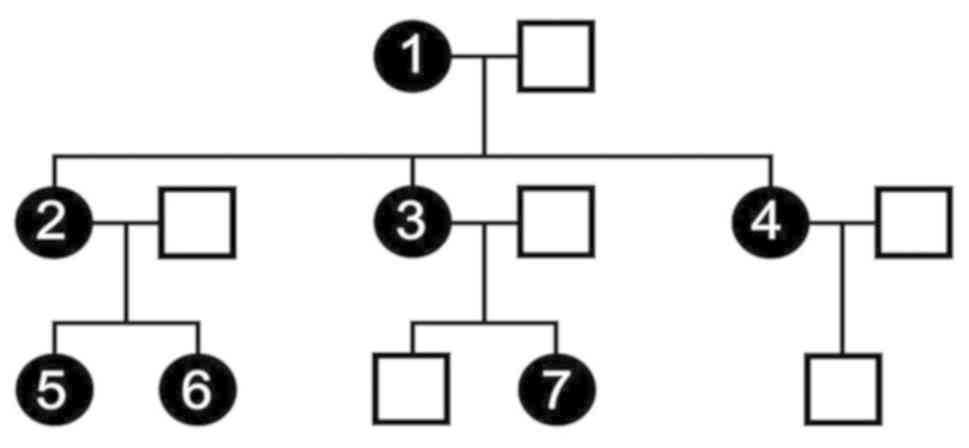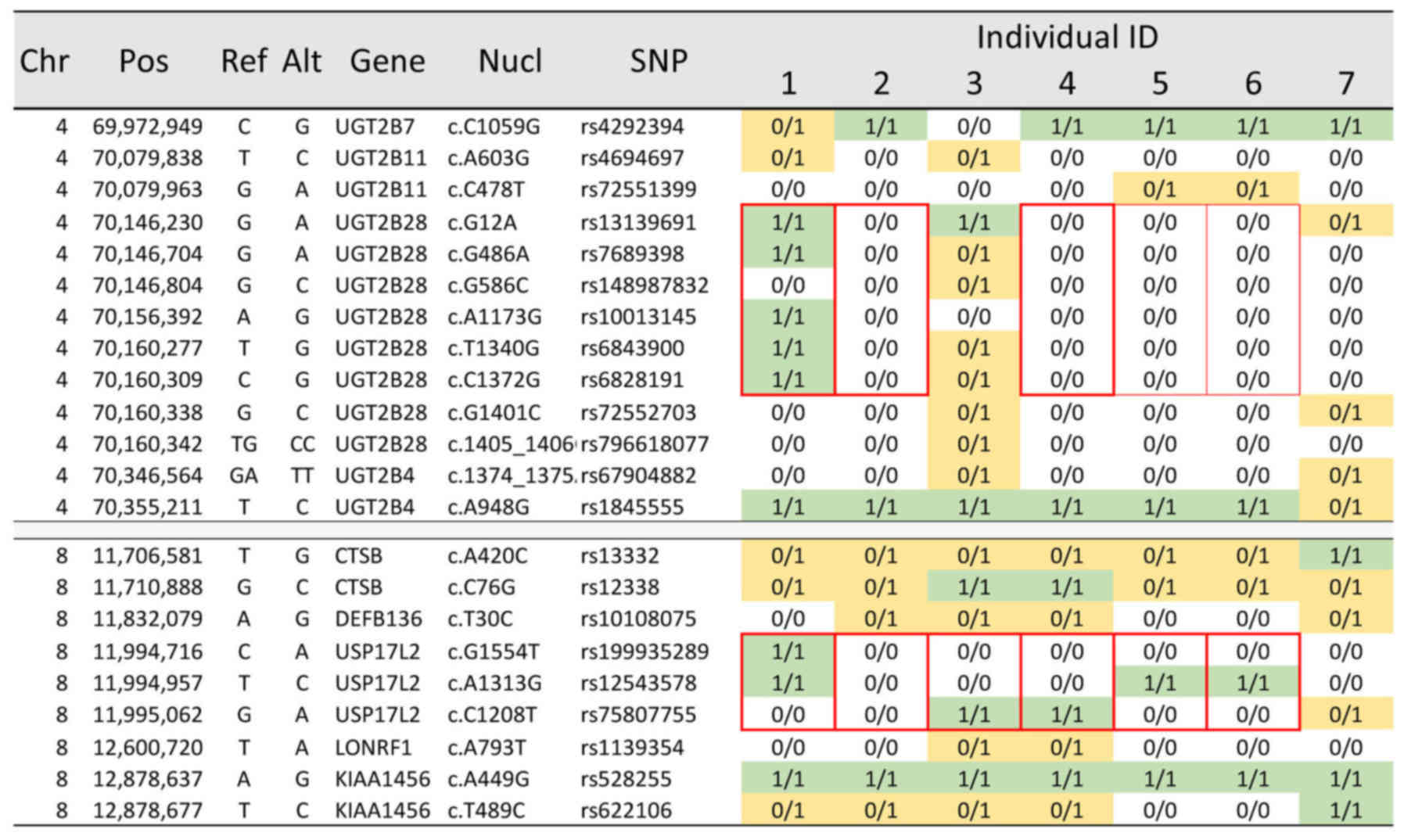|
1
|
Burney RO and Giudice LC: Pathogenesis and
pathophysiology of endometriosis. Fertil Steril. 98:511–519. 2012.
View Article : Google Scholar : PubMed/NCBI
|
|
2
|
Halis G and Arici A: Endometriosis and
inflammation in infertility. Ann N Y Acad Sci 1034. 300–315. 2004.
View Article : Google Scholar
|
|
3
|
Simpson JL, Elias S, Malinak LR and
Buttram VC Jr: Heritable aspects of endometriosis. I. Genetic
studies. Am J Obstet Gynecol. 137:327–331. 1980. View Article : Google Scholar : PubMed/NCBI
|
|
4
|
Hadfield RM, Mardon HJ, Barlow DH and
Kennedy SH: Endometriosis in monozygotic twins. Fertil Steril.
68:941–942. 1997. View Article : Google Scholar : PubMed/NCBI
|
|
5
|
Treloar SA, O'Connor DT, O'Connor VM and
Martin NG: Genetic influences on endometriosis in an Australian
twin sample. simplesueT@qimr.edu.au. Fertil
Steril. 71:701–710. 1999. View Article : Google Scholar : PubMed/NCBI
|
|
6
|
Saha R, Pettersson HJ, Svedberg P,
Olovsson M, Bergqvist A, Marions L, Tornvall P and Kuja-Halkola R:
Heritability of endometriosis. Fertil Steril. 104:947–952. 2015.
View Article : Google Scholar : PubMed/NCBI
|
|
7
|
Kobayashi H, Imanaka S, Nakamura H and
Tsuji A: Understanding the role of epigenomic, genomic and genetic
alterations in the development of endometriosis (review). Mol Med
Rep. 9:1483–1505. 2014. View Article : Google Scholar : PubMed/NCBI
|
|
8
|
Sapkota Y, Steinthorsdottir V, Morris AP,
Fassbender A, Rahmioglu N, De Vivo I, Buring JE, Zhang F, Edwards
TL, Jones S, et al iPSYCH-SSI-Broad Group, : Meta-analysis
identifies five novel loci associated with endometriosis
highlighting key genes involved in hormone metabolism. Nat Commun.
8:155392017. View Article : Google Scholar : PubMed/NCBI
|
|
9
|
Gao L, Emond MJ, Louie T, Cheadle C,
Berger AE, Rafaels N, Vergara C, Kim Y, Taub MA, Ruczinski I, et al
National Heart, Lung, and Blood Institute GO Exome Sequencing
Project, : Identification of rare variants in ATP8B4 as a risk
factor for systemic sclerosis by whole-exome sequencing. Arthritis
Rheumatol. 68:191–200. 2016. View Article : Google Scholar : PubMed/NCBI
|
|
10
|
Ng SB, Turner EH, Robertson PD, Flygare
SD, Bigham AW, Lee C, Shaffer T, Wong M, Bhattacharjee A, Eichler
EE, et al: Targeted capture and massively parallel sequencing of 12
human exomes. Nature. 461:272–276. 2009. View Article : Google Scholar : PubMed/NCBI
|
|
11
|
Matalliotakis M, Zervou MI, Matalliotaki
C, Arici A, Spandidos DA, Matalliotakis I and Goulielmos GN:
Genetic association study in a three-generation family with seven
members with endometriosis. Mol Med Rep. 16:6077–6080. 2017.
View Article : Google Scholar : PubMed/NCBI
|
|
12
|
Matalliotaki C, Matalliotakis M, Zervou
MI, Trivli A, Matalliotakis I, Mavromatidis G, Spandidos DA,
Albertsen HM, Chettier R, Ward K and Goulielmos GN: Co-existence of
endometriosis with 13 non-gynecological co-morbidities: Mutation
analysis by whole exome sequencing. Mol Med Rep. 18:5053–5057.
2018.PubMed/NCBI
|
|
13
|
Purcell S, Neale B, Todd-Brown K, Thomas
L, Ferreira MA, Bender D, Maller J, Sklar P, de Bakker PI, Daly MJ
and Sham PC: PLINK: A tool set for whole-genome association and
population-based linkage analyses. Am J Hum Genet. 81:559–575.
2007. View
Article : Google Scholar : PubMed/NCBI
|
|
14
|
Ng SB, Buckingham KJ, Lee C, Bigham AW,
Tabor HK, Dent KM, Huff CD, Shannon PT, Jabs EW, Nickerson DA, et
al: Exome sequencing identifies the cause of a mendelian disorder.
Nat Genet. 42:30–35. 2010. View
Article : Google Scholar : PubMed/NCBI
|
|
15
|
Girard SL, Gauthier J, Noreau A, Xiong L,
Zhou S, Jouan L, Dionne-Laporte A, Spiegelman D, Henrion E, Diallo
O, et al: Increased exonic de novo mutation rate in individuals
with schizophrenia. Nat Genet. 43:860–863. 2011. View Article : Google Scholar : PubMed/NCBI
|
|
16
|
Choi M, Scholl UI, Ji W, Liu T, Tikhonova
IR, Zumbo P, Nayir A, Bakkaloğlu A, Ozen S, Sanjad S, et al:
Genetic diagnosis by whole exome capture and massively parallel DNA
sequencing. Proc Natl Acad Sci USA. 106:19096–19101. 2009.
View Article : Google Scholar : PubMed/NCBI
|
|
17
|
Tephly TR and Burchell B:
UDP-glucuronosyltransferases: A family of detoxifying enzymes.
Trends Pharmacol Sci. 11:276–279. 1990. View Article : Google Scholar : PubMed/NCBI
|
|
18
|
Guillemette C, Lévesque E, Harvey M,
Bellemare J and Menard V: UGT genomic diversity: Beyond gene
duplication. Drug Metab Rev. 42:24–44. 2010. View Article : Google Scholar : PubMed/NCBI
|
|
19
|
Brønstad I, Wolff AS, Løvås K, Knappskog
PM and Husebye ES: Genome-wide copy number variation (CNV) in
patients with autoimmune Addison's disease. BMC Med Genet.
12:1112011. View Article : Google Scholar : PubMed/NCBI
|
|
20
|
Karypidis AH, Olsson M, Andersson S-O,
Rane A and Ekström L: Deletion polymorphism of the UGT2B17 gene is
associated with increased risk for prostate cancer and correlated
to gene expression in the prostate. Pharmacogenomics J. 8:147–151.
2008. View Article : Google Scholar : PubMed/NCBI
|
|
21
|
Nadeau G, Bellemare J, Audet-Walsh É,
Flageole C, Huang SP, Bao BY, Douville P, Caron P, Fradet Y,
Lacombe L, et al: Deletions of the androgen-metabolizing UGT2B
genes have an effect on circulating steroid levels and biochemical
recurrence after radical prostatectomy in localized prostate
cancer. J Clin Endocrinol Metab. 96:E1550–E1557. 2011. View Article : Google Scholar : PubMed/NCBI
|
|
22
|
Belledant A, Hovington H, Garcia L, Caron
P, Brisson H, Villeneuve L, Simonyan D, Têtu B, Fradet Y, Lacombe
L, et al: The UGT2B28 sex-steroid inactivation pathway is a
regulator of steroidogenesis and modifies the risk of prostate
cancer progression. Eur Urol. 69:601–609. 2016. View Article : Google Scholar : PubMed/NCBI
|
|
23
|
Nijman SM, Luna-Vargas MP, Velds A,
Brummelkamp TR, Dirac AM, Sixma TK and Bernards R: A genomic and
functional inventory of deubiquitinating enzymes. Cell.
123:773–786. 2005. View Article : Google Scholar : PubMed/NCBI
|
|
24
|
Burrows JF, McGrattan MJ, Rascle A,
Humbert M, Baek KH and Johnston JA: DUB-3, a cytokine-inducible
deubiquitinating enzyme that blocks proliferation. J Biol Chem.
279:13993–14000. 2004. View Article : Google Scholar : PubMed/NCBI
|
|
25
|
Shin JM, Yoo KJ, Kim MS, Kim D and Baek
KH: Hyaluronan- and RNA-binding deubiquitinating enzymes of USP17
family members associated with cell viability. BMC Genomics.
7:2922006. View Article : Google Scholar : PubMed/NCBI
|
|
26
|
Ilad RS, Fleming SD, Bebington CR and
Murphy CR: Ubiquitin is associated with the survival of ectopic
stromal cells in endometriosis. Reprod Biol Endocrinol. 2:692004.
View Article : Google Scholar : PubMed/NCBI
|
|
27
|
Zhou B, Shu B, Xi T, Su N and Liu J: Dub3
expression correlates with tumor progression and poor prognosis in
human epithelial ovarian cancer. Biomed Pharmacother. 70:84–89.
2015. View Article : Google Scholar : PubMed/NCBI
|
|
28
|
Lin Y, Wang Y, Shi Q, Yu Q, Liu C, Feng J,
Deng J, Evers BM, Zhou BP and Wu Y: Stabilization of the
transcription factors slug and twist by the deubiquitinase dub3 is
a key requirement for tumor metastasis. Oncotarget. 8:75127–75140.
2017.PubMed/NCBI
|
|
29
|
Blanco MJ, Moreno-Bueno G, Sarrio D,
Locascio A, Cano A, Palacios J and Nieto MA: Correlation of Snail
expression with histological grade and lymph node status in breast
carcinomas. Oncogene. 21:3241–3246. 2002. View Article : Google Scholar : PubMed/NCBI
|
|
30
|
Zhou BP, Deng J, Xia W, Xu J, Li YM,
Gunduz M and Hung MC: Dual regulation of Snail by
GSK-3beta-mediated phosphorylation in control of
epithelial-mesenchymal transition. Nat Cell Biol. 6:931–940. 2004.
View Article : Google Scholar : PubMed/NCBI
|
|
31
|
Thiery JP and Sleeman JP: Complex networks
orchestrate epithelial-mesenchymal transitions. Nat Rev Mol Cell
Biol. 7:131–142. 2006. View
Article : Google Scholar : PubMed/NCBI
|
|
32
|
Thiery JP, Acloque H, Huang RY and Nieto
MA: Epithelial-mesenchymal transitions in development and disease.
Cell. 139:871–890. 2009. View Article : Google Scholar : PubMed/NCBI
|
|
33
|
Albertsen HM and Ward K: Genes linked to
endometriosis by GWAS are integral to cytoskeleton regulation and
suggests that mesothelial barrier homeostasis is a factor in the
pathogenesis of endometriosis. Reprod Sci. 24:803–811. 2017.
View Article : Google Scholar : PubMed/NCBI
|











